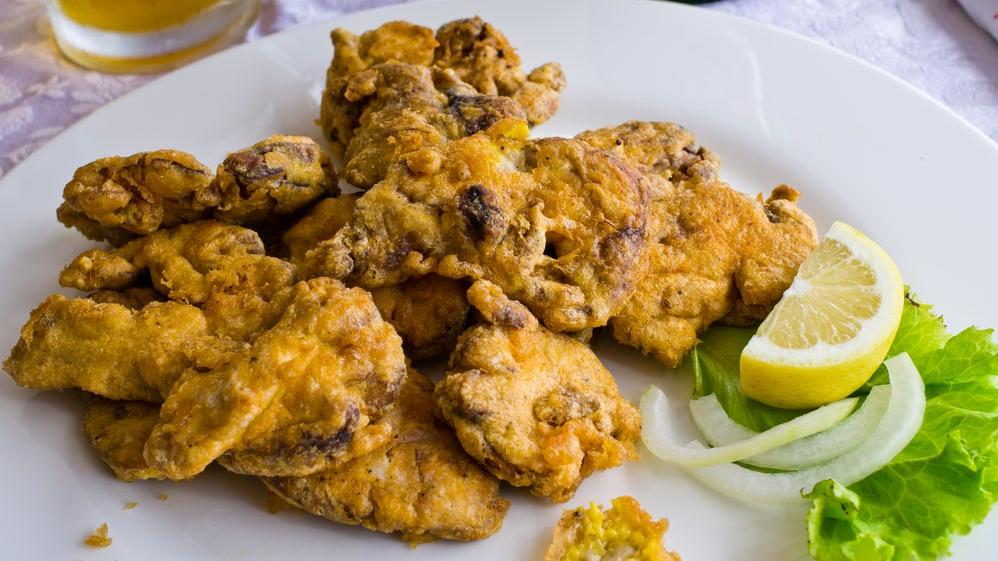A Brief History Of People Eating Brains
The tradition is more American than you might think.
You can learn a lot about a monster from what they eat. Vampires, the most erotic, need to find a neck for a sanguine slurp. Witches, the most intelligent, are always cooking something complicated and foreboding in a cauldron. Zombies, which exist to rob us of our humanity, eat brains.
In fact, zombies didn't eat brains in George Romero's canonical 1968 zombie horror Night of the Living Dead. Brain-eating was first introduced as a zombie trope 17 years later in the Dan O'Bannon-directed film Return of the Living Dead. And in 1992, The Simpsons revitalized the trope when it spoofed Return of the Living Dead. These (along with countless other examples in the years since) helped popularize zombies' myelin mania.
If anything, the zombies-eating-brains trope has done a disservice to our perception of the brain as a culinary protein. There is a much longer global tradition of humans preparing animal brains as a food; it is and has been an important part of many different cultures' cuisines. And like any other animal organ, civilization has had to figure out how to put it to use.
The fried brain sandwich, a Midwest specialty
There are, of course, many other cuts of meat that are more ambrosial, more pleasing than brain. It joins its oddball compatriots tripe, tongue, sweetbreads, and other offal as the less desirable and more, ahem, texturally adventurous of livestock's edible offerings, especially to an American palate.
However, one of the most interesting uses for brain comes from the United States: the disappearing Midwestern delicacy of fried brain sandwiches. As The Takeout's resident iron stomach, Dennis Lee prepared and reviewed a fried brain sandwich in 2018. Lee discusses the psychic resistance to eating brain when it's not a part of one's regular diet.
"Most offal is a lot easier to handle, mentally, but for some reason brains are some next-level shit," he writes. Presumably, the amount of importance we attribute to the functions of the brain puts the organ in the same category as animal hearts: somehow too vital to cook up and serve on our table. Yet in his (surprisingly?) positive review of the sandwich, Lee described its richness as "Meat creaminess: In so many words, this is what brains taste like."
In a Chicago Tribune article about brain sandwiches, the meal's history makes total sense, given the region's working-class roots. In places like St. Louis, Evansville in Indiana, and the Ohio River Valley, "The sandwich was immensely popular in its heyday — the mid-1900s to the '70s — back when the stockyards were up and running, and brains and other off-cuts were readily available."
From a nutritional perspective, brain is calorically dense and fatty, high in cholesterol. According to the Tribune, a fried brain sandwich was "perfect for someone who is working 12 to 14 hours in a packing house." But it's not just a big blob of fat—brains are a good source of DHA, an omega-3 fatty acid.
The decline of brains in American cuisine
The popularity of beef brain took a nosedive in the 1990s and early 2000s when a series of Mad Cow Disease cases occurred. Mad Cow Disease (known scientifically as Bovine Spongiform Encephalopathy) is one of a few types of scary, neurodegenerative diseases that are both fatal and transmissible to humans via infected animal meat. It would seem that brain is one of those foods that, to many, just doesn't seem worth the risk.
While the specter of Mad Cow is no longer a clear and present danger, combining its terrifying perception with the rarity of brain (both at grocery stores and on menus) and the public's already strong hesitancy against eating brain in the first place, the fried brain sandwich has not and probably will not recover its early 20th-century run of popularity.
Where to eat brain around the world
Despite America's rejection of brains, they're nonetheless eaten all over the world.
"Humans have been eating brains for about as long as we've been cooking anything," writes Taste Cooking. "The earliest cookbook (4th or 5th century AD), the Roman Apicius, included brains as the stuffing for sausages, and in the occasional brain-enriched eggy pudding flavored with roses, wine, or fruit."
Maghaz is the name of a brain-based dish in Indian cuisine that is eaten across India, Pakistan, and Bangladesh. The dish is a regional specialty in the Indian state of Hyperabad, where goat brain is fried and served with gravy. It is said the dish is a contribution of India's Muslim population, who consider wasting any part of an animal to be haram, going against Islamic law.
Pig brain is enjoyed in the Chinese province of Sichuan, where it is often added to hot pot dishes. It is especially worthwhile in the soup of the hot pot because brain tissue is good at soaking in the liquid.
Similar to the Midwestern sandwich, one popular method of preparing brain globally is to bread and deep-fry it. Such fritters are eaten across Europe and in Cuba. In Italy, it is known as frittelle di cervella.
If you are interested in trying brain, the easiest way to procure the choice protein is to call your local butcher. And if you'd rather not prepare it yourself, a good bet is trying to find brain tacos (sesos in Spanish), which, in addition to tongue, is a filling option that's not as commonplace on taqueria menus but not impossible to find. As Gastro Obscura so eloquently puts it, sesos are enjoyed because of their "soft, silky, almost custard-like texture." Yum? Yum.
